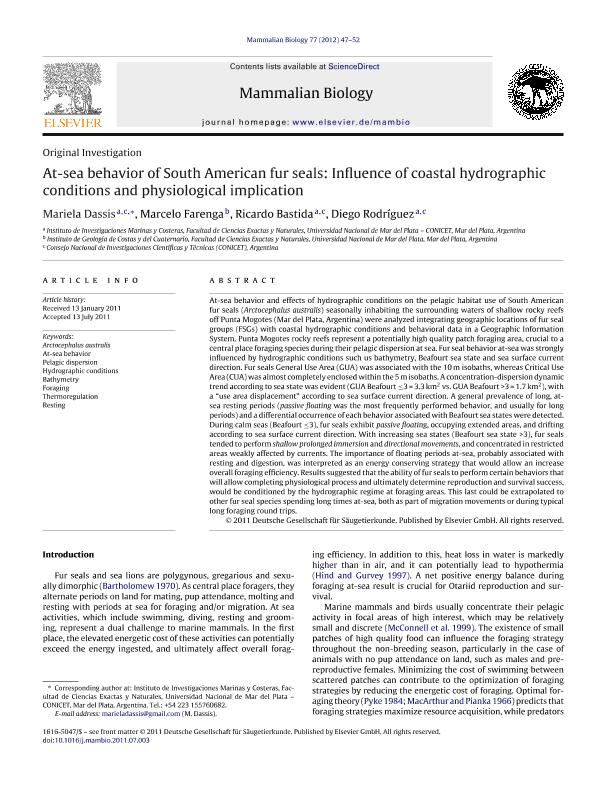Artículo
At-sea behaviour of South American fur seals: influence of coastal hydrographic conditions and physiological implicances
Fecha de publicación:
01/2012
Editorial:
Elsevier Gmbh
Revista:
Mammalian Biology
ISSN:
1616-5047
Idioma:
Inglés
Tipo de recurso:
Artículo publicado
Clasificación temática:
Resumen
At-sea behavior and effects of hydrographic conditions on the pelagic habitat use of South American fur seals (Arctocephalus australis) seasonally inhabiting the surrounding waters of shallow rocky reefs off Punta Mogotes (Mar del Plata, Argentina) were analyzed integrating geographic locations of fur seal groups (FSGs) with coastal hydrographic conditions and behavioral data in a Geographic Information System. Punta Mogotes rocky reefs represent a potentially high quality patch foraging area, crucial to a central place foraging species during their pelagic dispersion at sea. Fur seal behavior at-sea was strongly influenced by hydrographic conditions such us bathymetry, Beafourt sea state and sea surface current direction. Fur seals General Use Area (GUA) was associated with the 10m isobaths, whereas Critical Use Area (CUA) was almost completely enclosed within the 5misobaths. A concentration-dispersion dynamic trend according to sea state was evident (GUA Beafourt ≤3 = 3.3km2 vs. GUA Beafourt >3 = 1.7km2), with a ?use area displacement? according to sea surface current direction. A general prevalence of long, atsea resting periods (passive floating was the most frequently performed behavior, and usually for long periods) and a differential occurrence of each behavior associated with Beafourt sea states were detected. During calm seas (Beafourt ≤3), fur seals exhibit passive floating, occupying extended areas, and drifting according to sea surface current direction. With increasing sea states (Beafourt sea state >3), fur seals tended to perform shallow prolonged immersion and directional movements, and concentrated in restricted areas weakly affected by currents. The importance of floating periods at-sea, probably associated with resting and digestion, was interpreted as an energy conserving strategy that would allow an increase overall foraging efficiency. Results suggested that the ability of fur seals to perform certain behaviors that will allow completing physiological process and ultimately determine reproduction and survival success, would be conditioned by the hydrographic regime at foraging areas. This last could be extrapolated to other fur seal species spending long times at-sea, both as part of migration movements or during typical long foraging round trips.
Archivos asociados
Licencia
Identificadores
Colecciones
Articulos(CCT - MAR DEL PLATA)
Articulos de CTRO.CIENTIFICO TECNOL.CONICET - MAR DEL PLATA
Articulos de CTRO.CIENTIFICO TECNOL.CONICET - MAR DEL PLATA
Articulos(IIMYC)
Articulos de INSTITUTO DE INVESTIGACIONES MARINAS Y COSTERAS
Articulos de INSTITUTO DE INVESTIGACIONES MARINAS Y COSTERAS
Citación
Dassis, Mariela; Farenga, Marcelo Omar; Bastida, Ricardo Oscar; Rodriguez, Diego Horacio; At-sea behaviour of South American fur seals: influence of coastal hydrographic conditions and physiological implicances; Elsevier Gmbh; Mammalian Biology; 77; 1; 1-2012; 47-52
Compartir
Altmétricas




